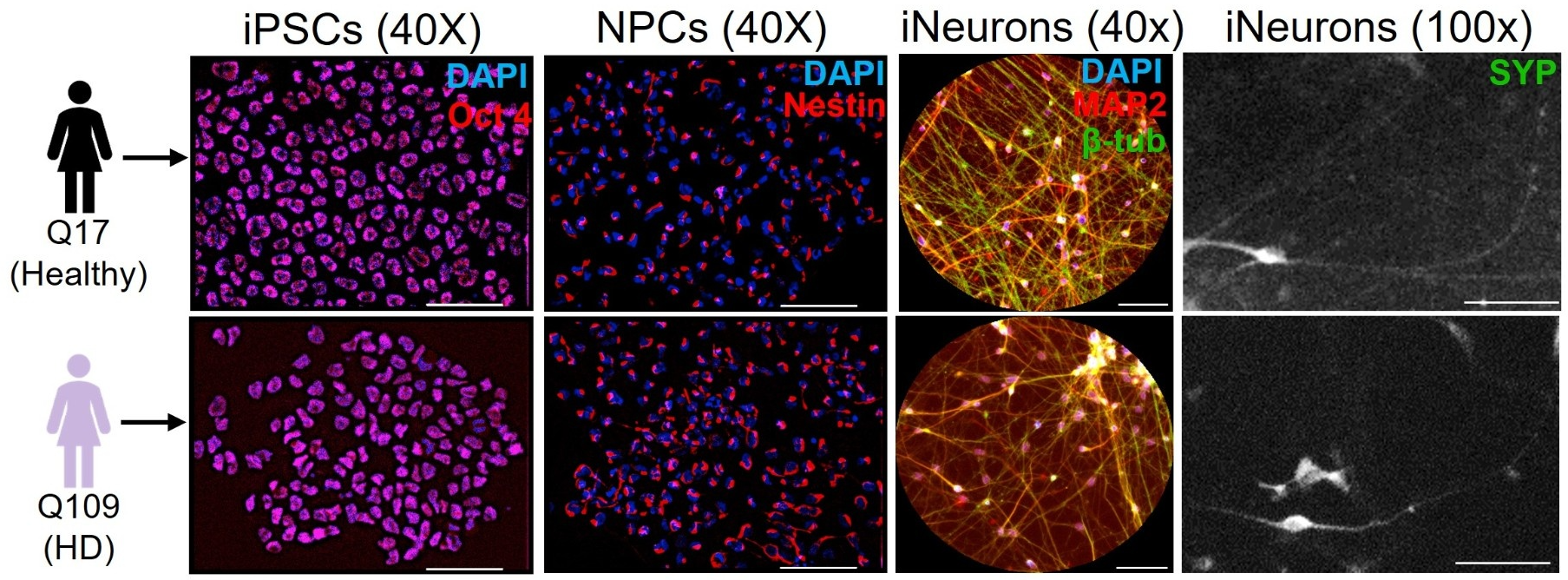Reviewed by Lexie CornerMay 6 2025
Ten years ago, researchers from the University at Buffalo provided some insight into a long-standing neuroscience conundrum: How exactly does Huntington's disease result from a mutation in the huntingtin protein (HTT)?
 A comparison of healthy human neurons with neurons of a Huntington’s disease patient, where GSK3ß and ERK1 were upregulated. Image Credit: Krzystek and Gunawardena/University at Buffalo
A comparison of healthy human neurons with neurons of a Huntington’s disease patient, where GSK3ß and ERK1 were upregulated. Image Credit: Krzystek and Gunawardena/University at Buffalo
Their investigation revealed that HTT functions similarly to a traffic controller within neurons, facilitating the movement of various cargoes along neuronal pathways known as axons in coordination with other essential proteins for cellular function and survival. A reduction in non-mutant HTT results in a neurological scenario akin to traffic jams and roadblocks.
Recently, researchers have gained further insights into the factors that can regulate the traffic-controlling HTT.
They discovered that two specific signaling proteins, GSK3ß and ERK1, were expressed at higher levels in the neurons of patients with Huntington’s disease. By inhibiting their function in the neurons of fruit fly larvae carrying a mutant HTT, they found that blocking GSK-3ß led to fewer defects in axonal transport and reduced neuronal cell death, whereas inhibiting ERK1 resulted in increased transport issues and greater cell death.
With these findings, we propose that ERK1 may protect neurons in the face of Huntington’s disease, while GSK3ß may exacerbate Huntington’s disease. Therapeutics may one day be able to target these signaling proteins in different ways, inhibiting GSK3ß and boosting ERK1, to treat this severe and fatal neurological disorder.”
Shermali Gunawardena, Ph.D., Associate Professor, Biological Sciences, College of Arts and Sciences, University at Buffalo
Gunawardena is the Corresponding Author of the study that details this research, which was published in Nature Cell Death & Disease.
Two Proteins, Two Opposing Effects
The mutation of the HTT gene results in the excessive repetition of the genetic sequence cytosine-adenine-guanine (CAG). The reason this leads to a decline in a person's physical and mental capabilities, typically beginning around middle age, remains unclear, as the normal function and purpose of HTT are not fully understood.
In a previous piece of this puzzle, Gunawardena’s team found that HTT moves along axonal highways by attaching to specific cellular cargo carriers known as vesicles, which are transported by motor proteins called dyneins and kinesins.
This time, we focused on the signalers that actually regulate this entire complex transport system: a group of proteins called kinases. Kinases modify HTT and other transport components by attaching molecular tags to them, known as phosphate groups.”
Thomas J. Krzystek, Study First Author, University at Buffalo
Krzystek earned a Ph.D. in Biological Sciences from UB in 2022 and is now a Senior Scientist at AbbVie.
The kinases GSK3ß and ERK1 caught the team's attention due to their elevated levels in neurons affected by Huntington’s disease compared to healthy neurons.
To investigate further, the researchers turned to a fruit fly model. When they inhibited GSK3ß in larvae with Huntington’s disease, they observed fewer axonal blockages and reduced neuronal cell death. The treated flies also showed improved crawling behavior.
In a previous study, they found that GSK3ß or glycogen synthase kinase-3beta regulates the activity of motor proteins, helping determine whether they should stop or keep moving. An imbalance in GSK-3ß levels can disrupt motor function and lead to traffic blockages through various mechanisms.
“So, while GSK3ß typically plays a positive role in neuronal function, it seems it may actually worsen an already problematic situation when confronted with a mutant HTT,” Gunawardena noted.
In contrast, inhibiting ERK1 (extracellular signal-regulated kinase) led to more axonal blockages and increased cell death.
Krzystek said, “The level of ERK1 is clearly important for Huntington’s disease, but whether it is directly modulating the mutant HTT remains uncertain. Regardless, the signaling from this ERK1 pathway appears to be neuroprotective in the context of Huntington’s disease.”
When the team raised ERK1 levels, they observed a reduction in both traffic blockages and neuronal cell death.
So long as it does not interfere with other processes that ERK1 might be involved in, future treatments could potentially enhance a patient’s ERK1 levels to reduce neuronal cell death. Once cells have died, there is not much that can be done, so our research aims to identify these critical early processes that lead to cell death and explore whether they can be prevented.
Shermali Gunawardena, Ph.D., Associate Professor, Biological Sciences, College of Arts and Sciences, University at Buffalo
Source:
Journal reference:
Krzystek, T. J., et al. (2025) Opposing roles for GSK3β and ERK1-dependent phosphorylation of huntingtin during neuronal dysfunction and cell death in Huntington’s disease. Cell Death and Disease. doi.org/10.1038/s41419-025-07524-0.